The Yanshanian Uranium Mineralization Age and Its Geological Significance in the Dashigou Carbonatite-Type Mo-REE-U Deposit, East Qinling Orogen, China
Abstract
:1. Introduction
2. Regional Geology
3. Deposit Geology
4. Samples and Analytical Methods
4.1. Sample Preparation
4.2. Analytical Methods
5. Results
5.1. Mineralogy of Uranium Minerals
5.2. Chemical Composition of Uraninite
5.3. U-Th-Pb Chemical Age of Uraninite
| Sample No | Y2O3 | Nb2O5 | P2O5 | FeO | CaO | TiO2 | SiO2 | La2O3 | Ce2O3 | PbO | ThO2 | UO2 | Yb2O3 | MgO | Total | Age (Ma) |
|---|---|---|---|---|---|---|---|---|---|---|---|---|---|---|---|---|
| 06BT-1 | 1.77 | 0.06 | 0.00 | 0.07 | 0.19 | 0.00 | 0.00 | 0.06 | 1.97 | 1.68 | 1.94 | 89.01 | 0.04 | 0.01 | 96.80 | 140 |
| 06BT-2 | 1.84 | 0.00 | 0.00 | 0.00 | 0.22 | 0.00 | 0.00 | 0.01 | 1.62 | 1.68 | 2.00 | 89.43 | 0.17 | 0.02 | 96.98 | 139 |
| 06BT-3 | 2.19 | 0.07 | 0.03 | 0.02 | 0.32 | 0.00 | 0.00 | 0.09 | 2.05 | 1.68 | 1.57 | 87.77 | 0.00 | 0.00 | 95.78 | 142 |
| 06BT-4 | 2.39 | 0.12 | 0.00 | 0.00 | 0.43 | 0.00 | 0.00 | 0.00 | 1.53 | 1.71 | 1.72 | 88.66 | 0.06 | 0.00 | 96.61 | 143 |
| 06BT-5 | 1.99 | 0.00 | 0.02 | 0.02 | 0.29 | 0.00 | 0.01 | 0.00 | 1.49 | 1.81 | 2.01 | 88.06 | 0.06 | 0.00 | 95.77 | 152 |
| 06BT-6 | 1.62 | 0.00 | 0.00 | 0.24 | 0.24 | 0.37 | 0.01 | 0.42 | 3.41 | 1.68 | 1.66 | 86.40 | 0.19 | 0.01 | 96.25 | 144 |
| 06BT-7 | 1.50 | 0.09 | 0.00 | 0.08 | 0.33 | 0.04 | 0.07 | 0.15 | 3.33 | 1.67 | 1.55 | 87.10 | 0.18 | 0.03 | 96.12 | 142 |
| 06BT-8 | 1.86 | 0.12 | 0.01 | 0.00 | 0.36 | 0.08 | 0.51 | 0.16 | 3.78 | 1.72 | 1.75 | 85.86 | 0.27 | 0.01 | 96.51 | 148 |
| 06BT-9 | 1.66 | 0.00 | 0.01 | 0.03 | 0.32 | 0.00 | 0.07 | 0.36 | 3.19 | 1.68 | 1.52 | 85.61 | 0.28 | 0.01 | 94.74 | 145 |
| 06BT-10 | 2.39 | 0.02 | 0.00 | 0.11 | 0.34 | 0.23 | 0.00 | 0.22 | 3.41 | 1.71 | 1.81 | 86.60 | 0.00 | 0.00 | 96.84 | 146 |
| 06BT-11 | 2.07 | 0.03 | 0.01 | 0.03 | 0.33 | 0.08 | 0.01 | 0.27 | 3.13 | 1.70 | 1.66 | 86.40 | 0.04 | 0.00 | 95.77 | 146 |
| 10-Ur-1 | 1.85 | 0.00 | 0.00 | 0.00 | 0.25 | 0.00 | 0.03 | 0.00 | 1.72 | 1.70 | 2.09 | 90.00 | 0.22 | 0.03 | 97.88 | 140 |
| 10-Ur-2 | 1.69 | 0.02 | 0.00 | 0.07 | 0.27 | 0.00 | 0.06 | 0.00 | 1.55 | 1.68 | 2.09 | 90.00 | 0.02 | 0.02 | 97.46 | 138 |
| 10-Ur-3 | 1.72 | 0.11 | 0.02 | 0.11 | 0.39 | 0.00 | 0.03 | 0.00 | 2.20 | 1.72 | 2.13 | 87.95 | 0.00 | 0.02 | 96.39 | 145 |
| 10-Ur-4 | 1.98 | 0.06 | 0.00 | 0.00 | 0.39 | 0.00 | 0.03 | 0.00 | 1.96 | 1.67 | 1.73 | 88.43 | 0.39 | 0.00 | 96.63 | 140 |
| 10-Ur-5 | 1.87 | 0.02 | 0.00 | 0.06 | 0.34 | 0.00 | 0.04 | 0.12 | 1.65 | 1.81 | 1.65 | 89.04 | 0.06 | 0.00 | 96.65 | 150 |
| 10-Ur-6 | 1.94 | 0.06 | 0.01 | 0.00 | 0.26 | 0.00 | 0.00 | 0.07 | 1.67 | 1.74 | 1.80 | 91.75 | 0.30 | 0.01 | 99.60 | 140 |
| 10-Ur-7 | 1.92 | 0.00 | 0.00 | 0.15 | 0.38 | 0.00 | 0.00 | 0.00 | 2.31 | 1.72 | 1.73 | 90.70 | 0.00 | 0.02 | 98.93 | 140 |
| 10-Ur-8 | 4.40 | 0.00 | 0.01 | 0.36 | 0.28 | 0.00 | 0.10 | 0.00 | 1.32 | 1.75 | 0.76 | 89.77 | 0.26 | 0.01 | 99.01 | 145 |
| 10-Ur-9 | 3.27 | 0.00 | 0.01 | 0.19 | 0.15 | 0.58 | 0.00 | 0.02 | 2.24 | 1.86 | 1.99 | 88.72 | 0.16 | 0.03 | 99.21 | 155 |
| 10-Ur-10 | 3.02 | 0.08 | 0.05 | 0.93 | 0.39 | 0.17 | 0.05 | 0.14 | 1.37 | 1.82 | 1.64 | 90.17 | 0.45 | 0.02 | 100.29 | 149 |
6. Discussion
6.1. Composition Characteristics and Indicative Significance of Uraninite
6.2. Determination of the Validity of U-Th-Pb Chemical Ages of Uraninite
6.3. Yanshanian Uranium Mineralization Age and Its Geological Significance
6.4. Structural Background of Yanshanian Uranium Mineralization
7. Conclusions
- (1)
- The Yanshanian uranium minerals in the carbonates of the Dashigou deposit are primarily represented by uraninite, which often exhibits irregular, subangular, grid-like, or flecked distributions, and overall presents a mineral assemblage characterized by uraninite + rutile + bastnäsite + parisite or brannerite.
- (2)
- The EPMA U-Th-Pb chemical age of uraninite is 144 ± 3.1 Ma, which represents the Yanshanian uranium mineralization age in the deposit. The newly discovered uranium mineralization age indicates that the deposit experienced a uranium remobilization event during the Cretaceous, possibly representing reactivation of early uranium mineral assemblages.
- (3)
- The Yanshanian uranium mineralization in the Dashigou deposit formed in an intracontinental orogenic and extensional environment following collisional orogeny.
Author Contributions
Funding
Data Availability Statement
Acknowledgments
Conflicts of Interest
References
- Woolley, A.R.; Kempe, D.R. Carbonatites: Nomenclature, average chemical compositions, and element distribution. In Carboratites: Genesis and Evolution; Bell, Ed.; Unwin Hyman: London, UK, 1989; pp. 1–14. [Google Scholar]
- Fan, H.R.; Hu, F.F.; Yang, K.F.; Pirahno, F.; Liu, X.; Wang, K.Y. Integrated U-Pb and Sm-Nd geochronology for a REE-rich carbonatite dyke at the giant Bayan Obo REE deposit, Northern China. Ore Geol. Rev. 2014, 63, 510–519. [Google Scholar] [CrossRef]
- She, H.D.; Fan, H.R.; Yang, K.F.; Li, X.H.; Wang, Z.Y. REEs upgrading by post-carbonatite fluids in the Huangshui’an Mo-REE deposit, eastern Qinling Orogen (central China). Ore Geol. Rev. 2022, 150, 105177. [Google Scholar] [CrossRef]
- Wang, Q.; Yang, W.B.; Niu, H.C.; Li, N.B.; Mitchell, R.H.; Zurevinski, S.; Wu, D. Formation of the Maoniuping giant REE deposit: Constraints from mineralogy and in situ bastnäsite U-Pb geochronology. Am. Miner. 2022, 107, 282–293. [Google Scholar] [CrossRef]
- Huang, G.W.; Pan, C.R.; Pan, J.Y.; Zhong, F.J.; Chen, Z.L.; Xia, F.; Yan, J.; Wu, D.H.; Min, Z.; Bonnetti, C.; et al. REE mineralization age and geodynamic setting of the Huanglongpu deposit in the East Qinling orogen, China: Evidence from mineralogy, U–Pb geochronology, and in-situ Nd isotope. Ore Geol. Rev. 2023, 152, 105255. [Google Scholar] [CrossRef]
- Huang, G.W.; Pan, C.R.; Pan, J.Y.; Zhong, F.J.; Yan, J.; Xia, F.; Du, H.F.; Zhang, T.; Wan, J.J.; Kang, Q.Q. The geochronology research on uraninite in the Dashigou carbonate-type molybdenum deposit of East Qinling area and its geological significance. Acta Geol. Sin. 2023, 97, 1917–1937. (In Chinese) [Google Scholar]
- Liu, S.; Fan, H.R.; Wang, Q.W.; Liu, Y.J.; Wei, W. Carbonatite-related delicate REE mineralization processes revealed by fluorocarbonates and monazite: Insights from the giant Bayan Obo REE-Nb-Fe deposit, China. Ore Geol. Rev. 2023, 157, 105443. [Google Scholar] [CrossRef]
- Dahlkamp, F.J. Classification of uranium deposits. Miner. Depos. 1978, 13, 83–104. [Google Scholar] [CrossRef]
- Zhang, G.W.; Zhang, Z.Q.; Dong, Y.P. Nature of main tectono–lithostratigraphic units of the Qinling Orogen: Implications for the tectonic evolution. Acta Petrol. Sin. 1995, 11, 101–114. (In Chinese) [Google Scholar]
- Mao, J.W.; Xie, G.Q.; Zhang, Z.H.; Li, X.F.; Wang, Y.T.; Zhang, C.Q.; Li, Y.F. Mesozoic large-scale pulses in North China and corresponding geodynamic settings. Acta Petrol. Sin. 2005, 21, 169–188. (In Chinese) [Google Scholar]
- Li, N.; Chen, Y.J.; Zhang, H.; Zhao, T.P.; Deng, X.H.; Wang, Y.; Ni, Z.Y. 2007. Molybdenum deposits in East Qinling. Earth Sci. Front. 2007, 14, 186–198. (In Chinese) [Google Scholar]
- Dong, Y.P.; Santosh, M. Tectonic architecture and multiple orogeny of the Qinling Orogenic Belt. Central China. Gondwana Res. 2016, 9, 1–40. [Google Scholar] [CrossRef]
- Li, N.; Pirajnom, F. Early Mesozoic Mo mineralization in the Qinling Orogen: An overview. Ore Geol. Rev. 2017, 81, 431–450. [Google Scholar] [CrossRef]
- Cai, Y.Q.; Zhang, J.D.; Li, Z.Y.; Guo, Q.Y.; Song, J.Y.; Fan, H.H.; Liu, W.S.; Qi, F.C.; Zhang, M.L. Outline of uranium resources characteristics and metallogenetic regularity in China. Acta Geol. Sin-Engl. 2015, 89, 918–937. [Google Scholar]
- Gao, L.G.; Chen, Y.W.; Bi, X.W.; Hu, R.Z.; Gao, C.; Dong, S.H.; Luo, J.C. Chronology and mineral chemistry of the uranium minerals in Huayangchuan uranium-niobium deposit, Shaanxi province and its implications for uranium mineralization. Acta Geol. Sin. 2019, 93, 2273–2291. (In Chinese) [Google Scholar]
- Huang, H.; Wang, K.X.; Cuney, M.; Pan, J.Y.; Bonnetti, C.; Liu, X.D.; Zhong, F.J. Mesozoic magmatic and hydrothermal uranium mineralization in the Huayangchuan carbonatite-hosted U-Nb-polymetallic deposit, North Qinling Orogen (Central China): Evidence from uraninite chemical and isotopic compositions. Ore Geol. Rev. 2022, 146, 104958. [Google Scholar] [CrossRef]
- Huang, G.W.; Pan, J.Y.; Xia, F.; Yan, J.; Zhang, C.Y.; Wu, D.H.; Liu, Y. Provenance of uranium mineralization of the Yuqia area, Northwest China: Constraints from detrital zircon U-Pb geochronology and Hf isotopes. J. Earth Sci. 2022, 33, 1549–1570. [Google Scholar] [CrossRef]
- Bai, T.; Chen, W.; Jiang, S.Y. Evolution of the carbonatite Mo-HREE deposits in the Lesser Qinling Orogen: Insights from in situ geochemical investigation of calcite and sulfate. Ore Geol. Rev. 2019, 113, 103069. [Google Scholar] [CrossRef]
- Feng, J.Y.; Tang, L.; Yang, B.C.; Santosh, M.; Zhang, S.T.; Xu, B.; Kim, S.W.; Sheng, Y.M. Bastnäsite U-Th-Pb age, sulfur isotope and trace elements of the Huangshui’an deposit: Implications for carbonatite-hosted Mo-Pb-REE mineralization in the Qinling Orogenic Belt. China. Ore Geol. Rev. 2022, 143, 104790. [Google Scholar] [CrossRef]
- Huang, D.H.; Wang, Y.C.; Nie, F.J.; Jiang, X.J. A new type of molybdenum deposit–geological characteristics and metal-logenic mechanism of the Huanglongpu carbonatite vein-type of molybdenum (lead) deposit, Shanxi. Acta Geol. Sin. 1985, 59, 241–257. (In Chinese) [Google Scholar]
- Xu, C.; Song, W.L.; Qi, L.; Wang, L.J. Geochemical characteristics and tectonic setting of ore-bearing carbonatites in Hunglongpu Mo ore field. Acta Petrol. Sin. 2009, 25, 422–430. (In Chinese) [Google Scholar]
- Song, W.L.; Xu, C.; Smith, M.P.; Kynicky, J.; Huang, K.J.; Wei, C.W.; Zhou, L.; Shu, Q.H. Origin of unusual HREE-Mo-rich carbonatites in the Qinling Orogen, China. Sci. Rep. 2016, 6, 37377. [Google Scholar] [CrossRef] [PubMed]
- Smith, M.; Kynicky, J.; Xu, C.; Song, W.L.; Spratt, J.; Jeffries, T.; Brtnicky, M.; Kopriva, A.; Cangelosi, D. The origin of secondary heavy rare earth element enrichment in carbonatites: Constraints from the evolution of the Huanglongpu district, China. Lithos 2018, 308, 65–82. [Google Scholar] [CrossRef]
- Zhang, Y.Y.; Zhong, F.J.; Du, J.Y.; Yan, J.; Pan, C.R.; Huang, H.; Kang, Q.Q.; Pan, J.Y. Application of μ-XRF in uranium mineralogy of Huanglongpu carbonate-type molybdenum deposit, Shanxi province, China. Rock and Miner. Anal. 2022, 41, 32–42. (In Chinese) [Google Scholar]
- Huang, D.H.; Wu, C.Y.; Du, A.D.; He, H.L. Re-Os isotope ages of molybdenum deposits in east Qinling and their significance. Miner. Dep. 1994, 13, 221–230. (In Chinese) [Google Scholar] [CrossRef]
- Stein, H.J.; Markey, R.J.; Morgan, J.W. Highly precise and accurate Re-Os ages for molybdenite from the East Qinling molybdenum ore belt, Shaanxi province, China. Econ. Geol. 1997, 92, 827–835. [Google Scholar] [CrossRef]
- Wang, J.Y.; Li, Z.D.; Zhang, Q.; Li, C.; Xie, Y.; Li, G.Y.; Zeng, W.; Ding, N. Metallogenic epoch of the carbonatite-type Mo-U polymetallic deposit in east Qinling: Evidence from the monazite LA-ICP-MS U-Pb and molybdenite Re-Os isotopic dating. Acta Geol. Sin. 2020, 94, 2946–2964. (In Chinese) [Google Scholar]
- Huang, D.H.; Hou, Z.Q.; Yang, Z.M.; Li, Z.Q.; Xu, D.X. Geological and geochemical characteristics, metallogenetic mechanism and tectonic setting of carbonatite vein-type Mo (Pb) deposits in the East Qinling molybdenum ore belt. Acta Geol. Sin. 2009, 83, 1968–1984. (In Chinese) [Google Scholar]
- Huang, H.; Pan, J.Y.; Hong, B.Y.; Kang, Q.Q.; Zhong, F.J. EPMA chemical U-Th-Pb dating of uraninite in Huayangchuan U-polymetallic deposit Shaanxi Province and its geological significance. Miner. Dep. 2020, 39, 351–368. (In Chinese) [Google Scholar]
- Mercadier, J.; Annesiey, I.R.; Mckechnie, C.L.; Bogdan, T.S.; Creighton, S. Magmatic and Metamorphic Uraninite mineralization in the Western margin of the Trans-Hudson Orogen (Saskatchewan, Canada): A uranium Source for Unconformity-Related uranium deposits? Econ. Geol. 2013, 108, 1037–1065. [Google Scholar] [CrossRef]
- Wei, L.M.; Wang, L.; Zhang, G.H.; Zhu, W.F.; Wang, X.X.; Wang, D.H.; Wang, R. Study on the uraninite in Shirenzhang tungsten deposits, Guangdong Province. Acta Petrol. Sin. 2014, 88, 805–813. (In Chinese) [Google Scholar]
- Zhang, L.; Chen, Z.Y.; Tian, Z.J.; Huang, G.L. The application of electron microprobe dating method on uranium minerals in Changjiang granite, Northern Guangdong. Rock Miner. Anal. 2016, 35, 98–107. (In Chinese) [Google Scholar]
- Tang, A.; Li, G.L.; Su, Y.; Guo, G.L.; Wei, X.L.; Liu, Z.Y.; Chen, G.X. EPMA chemical U-Th-Pb dating of uraninite in Ziyunshan granite, Center Jiangxi Province. Earth Sci. 2017, 42, 378–388. (In Chinese) [Google Scholar]
- Xue, S.; Ling, M.X.; Liu, Y.L.; Kang, Q.Q.; Huang, R.F.; Zhang, Z.K.; Sun, W.D. The formation of the giant Huayangchuan U-Nb deposit associated with carbonatite in the Qingling Orogenic Belt. Ore Geol. Rev. 2020, 122, 103498. [Google Scholar] [CrossRef]
- Dong, Y.P.; Sun, S.S.; Santosh, M.; Zhao, J.; Sun, J.P.; He, D.F.; Shi, X.H.; Hui, B.; Cheng, C.; Zhang, G.W. Central China Orogenic Belt and amalgamation of East Asian continents. Gondwana Res. 2021, 100, 131–194. [Google Scholar]
- Jiang, H.J.; Yang, C.S.; Wang, D.Q.; Zheng, H.; Li, J.; Chen, H.Y. Multiple-stage mineralization in the Huayangchuan U-REE-Mo-Cu-Fe Ore Belt of the Qinling Orogen, Central China: Geological and Re-Os geochronological constraints. J. Earth Sci. 2022, 33, 193–204. [Google Scholar] [CrossRef]
- Zhang, G.W.; Cheng, S.Y.; Guo, A.L.; Dong, Y.P.; Lai, S.C.; Yao, A.P. Mianlue paleo-suture on the southern margin of the Central Orogenic System in Qinling-Dabie-with a discussion of the assembly of the main part of the continent of China. Geol. Bull. China 2004, 23, 846–853. (In Chinese) [Google Scholar]
- Dong, Y.P.; Zhang, G.W.; Hauzenberger, C. Palaeozoic tectonics and evolutionary history of the Qinling orogen: Evidence from geochemistry and geochronology of ophiolite and related volcanic rocks. Lithos 2011, 122, 39–56. [Google Scholar] [CrossRef]
- Li, N.; Chen, Y.J.; Santosh, M.; Pirajno, F. Compositional polarity of Triassic granitoids in the Qinling Orogen, China: Implication for termination of the northernmost paleo–Tethys. Gondwana Res. 2015, 27, 244–257. [Google Scholar] [CrossRef]
- Zhang, W.; Chen, W.T.; Gao, J.F.; Chen, H.K.; Li, J.H. Two episodes of REE mineralization in the Qinling Orogenic Belt, Central China: In-situ U-Th-Pb dating of bastnäsite and monazite. Miner. Depos. 2019, 54, 1265–1280. [Google Scholar] [CrossRef]
- Ren, J.S.; Zhu, J.B.; Li, C.; Liu, R.Y. Is the Qinling orogen an Indosinian collisional orogenic belt? Earth Sci. 2019, 44, 1476–1486. (In Chinese) [Google Scholar]
- Yang, C.S.; Zhao, L.D.; Zheng, H.; Wang, D.Q. The multiple granitic magmatism in the giant Huayangchuan uranium polymetallic ore district: Implications for tectonic evolution of the southern margin of North China Craton in the Qinling Orogen. Ore Geol. Rev. 2019, 112, 103055. [Google Scholar] [CrossRef]
- Xu, C.; Wang, L.; Song, W.; Wu, M. Carbonatites in China: A review for genesis and mineralization. Geosci. Front. 2010, 1, 105–114. [Google Scholar] [CrossRef]
- Xu, C.; Kynicky, J.; Chakhmouradian, A.R.; Qi, L.; Song, W. A unique Mo deposit associated with carbonatites in the Qinling orogenic belt, central China. Lithos 2010, 118, 50–60. [Google Scholar] [CrossRef]
- Xu, C.; Taylor, R.N.; Kynicky, J.; Chakhmouradian, A.R.; Song, W.; Wang, L. The origin of enriched mantle beneath North China block: Evidence from young carbonatites. Lithos 2011, 127, 1–9. [Google Scholar] [CrossRef]
- Song, W.L.; Xu, C.; Qi, L.; Zhou, L.; Wang, L.J.; Kynicky, J. Genesis of Si-rich carbonatites in Huanglongpu Mo deposit, Lesser Qinling Orogen, China and sig-nifificance for Mo mineralization. Ore Geol. Rev. 2015, 64, 756–765. [Google Scholar] [CrossRef]
- Huang, G.W.; Wu, D.H.; Huang, G.N.; Xue, W.W.; Min, Z.; Fan, P.F. Provenance of Jurassic Sediments from Yuqia Sandstone-Type Uranium Deposits in the Northern Margin of Qaidam Basin, China and Its Implications for Uranium Mineralization. Minerals 2022, 12, 82. [Google Scholar] [CrossRef]
- Bowles, J.F.W. Age dating of individual grains of uraninite in rocks from electron microprobe analyses. Chem. Geol. 1990, 83, 47–53. [Google Scholar] [CrossRef]
- Votyakov, S.; Ivanov, K.S.; Khiller, V.V. Chemical microprobe grains from granites of the Yamal Crystaline Basement. Doklady Earth Sci. 2011, 439, 994–997. [Google Scholar] [CrossRef]
- Luo, J.C.; Shi, S.H.; Chen, Y.W.; Tian, J.J. Review on dating of uranium mineralization. Acta Petrol. Sin. 2019, 35, 589–605. (In Chinese) [Google Scholar]
- Guo, G.L.; Zhang, Z.S.; Liu, X.D.; Feng, Z.S.; Lai, D.R.; Zhou, W.T. EPMA chemical U-Th-Pb dating of uraninite in Guangshigou uranium deposit. East China Inst. Technol. Nat. Sci. 2012, 35, 309–314. (In Chinese) [Google Scholar]
- Ludwig, K.R. Isotopic: A Plotting and Gegression Program for Radiogenic-Isotope Data, Version 2.53; Open-File Report; U.S. Geological Survey: Reston, VA, USA, 1991. [Google Scholar] [CrossRef]
- Janeczek, J.; Ewing, R.C. Structural formula of uraninite. J. Nucl. Mater. 1992, 190, 128–132. [Google Scholar] [CrossRef]
- Deditius, A.P.; Utsunomiya, S.; Ewing, R.C. Alteration of UO2+x under oxidizing conditions, Marshall Pass, Colorado, USA. J. Alloys Compo 2007, 444–445, 584–589. [Google Scholar] [CrossRef]
- Chen, Y.W.; Hu, R.Z.; Luo, J.C.; Dong, S.H. In-situ mineral chemistry and chronology analyses of the pitchblende in the Shazijiang uranium deposit and their implications for mineralization. Acta Petrol. Sin. 2019, 35, 2679–2694. (In Chinese) [Google Scholar]
- Bastrakov, E.N.; Jaireth, S.; Mernagh, T.P. Solubility of uranium in hydrothermal fluids at 25~300 °C: Implications for the formation of uranium deposits. Geosci. Aust. Canberra Aust. 2010, 29, 1–81. [Google Scholar]
- Mercadier, J.; Cuney, M.; Lach, P.; Boiron, M.C.; Bonhoure, J.; Richard, A.; Leisen, M.; Kister, P. Origin of uranium deposits revealed by their rare earth element signature. Terra Nova 2011, 23, 264–269. [Google Scholar] [CrossRef]
- Frimmel, H.E.; Schedel, S.; Brätz, H. Uraninite chemistry as forensic tool for provenance analysis. Appl. Geochem. 2014, 48, 104–121. [Google Scholar] [CrossRef]
- Macmillan, E.; Cook, N.J.; Ehrig, K.; Ciobanu, C.L.; Pring, A. Uraninite from the Olympic Dam IOCG-U-Ag deposit: Linking textural and compositional variation to temporal evolution. Am. Miner. 2016, 101, 1295–1320. [Google Scholar] [CrossRef]
- Mukhopadhyay, J.; Mishra, B.; Chakrabarti, K.; De, S.; Ghosh, G. Uraniferous paleoplacers of the Meso-Archean Mahagiri quartzite, Singhbhum Craton, India: Depositional controls, nature and source of >3.0 Ga detrital uraninites. Ore Geol. Rev. 2016, 72, 1290–1306. [Google Scholar] [CrossRef]
- Grandstaff, D.E. A kinetic study of the dissolution of uraninite. Econ. Geol. 1976, 71, 1493–1506. [Google Scholar] [CrossRef]
- Fryer, B.J.; Taylor, R.P. Rare-earth element distributions in uraninites: Implications for ore genesis. Chem. Geol. 1987, 63, 101–108. [Google Scholar] [CrossRef]
- Förster, H.J. The chemical composition of uraninite in Variscan granites of the Erzgebirge, Germany. Mineral. Mag. 1999, 63, 239–252. [Google Scholar] [CrossRef]
- Alexandre, P.; Kyser, T.K. Effects of cationic substitutions and alteration in uraninite, and implications for the dating of uranium deposits. Can. Miner. 2005, 43, 1005–1017. [Google Scholar] [CrossRef]
- Eglinger, A.; André-Mayer, A.S.; Vanderhaeghe, O.; Mercadier, J.; Cuney, M.; Decrée, S.; Feybesse, J.F.; Milesi, J.P. Geochemical signatures of uranium oxides in the Lufilian belt: From unconformity-related to syn-metamorphic uranium deposits during the Pan-African orogenic cycle. Ore Geol. Rev. 2013, 54, 197–213. [Google Scholar] [CrossRef]
- Kotzer, T.G.; Kyser, T.K. O, U, and Pb isotopic and chemical variations in uraninite: Implications for setermining the temporal and fluid history of ancient terrains. Am. Miner. 1993, 78, 1262–1274. [Google Scholar]
- Kempe, U. Precise electron microprobe age determination in altered uraninite: Consequences on the intrusion age and the metallogenic significance of the Kirchberg granite (Erzgebirge, Germany). Contrib. Mineral. Petr. 2003, 145, 107–118. [Google Scholar] [CrossRef]
- Zhao, H.J.; Ye, H.S.; Li, C. Re-Os dating of molybdenite from the Shijiawan molybdenum deposit in Shaanxi Province and its geological implications. Acta Petrol. Min. 2013, 32, 90–98. (In Chinese) [Google Scholar]
- Mao, J.W.; Xie, G.Q.; Bierlein, F.; Qu, W.J.; Du, A.D.; Ye, H.S.; Pirajno, F.; Li, H.M.; Guo, B.J.; Li, Y.F.; et al. Tectonic implications from Re–Os dating of Mesozoic molybdenum deposits in the East Qinling–Dabie orogenic belt. Geochim. Cosmochim. Acta. 2008, 72, 4607–4626. [Google Scholar] [CrossRef]
- Mao, J.W.; Zhang, Z.H.; Yu, J.J.; Wang, Y.T.; Niu, B.G. Mesozoic tectonic setting of largescale ore-forming in east China and adjacent areas: Revealed by precise ages of metallic deposits. Sci. Chin. 2003, 33, 289–299. (In Chinese) [Google Scholar]
- Zhu, L.M.; Zhang, G.W.; Guo, B.; Li, B. U-Pb (LA-ICP-MS) zircon dating for the large Jinduicheng porphyry Mo deposit in the East Qinling, China, and its metallogenetic geodynamical setting. Acta Geol. Sin. 2008, 82, 2040–2220. (In Chinese) [Google Scholar]
- Zhu, L.M.; Zhang, G.W.; Guo, B.; Lee, B.; Gong, H.J.; Wang, F. Geochemistry of the Jinduicheng Mo-bearing porphyry and deposit, and its implications for the geodynamic setting in East Qinling, P.R. China. Chem. Erde-Geochem. 2010, 70, 159–174. [Google Scholar] [CrossRef]
- Jiao, J.G.; Tang, Z.L.; Qian, Z.Z.; Yuan, H.C.; Yan, H.Q.; Sun, T.; Xu, G.; Li, X.D. Metallogenic mechanism, magma source and zircon U-Pb age of Jinduicheng granitic porphyry, East Qinling. J. Earth Sin. 2010, 35, 1011–1022. (In Chinese) [Google Scholar]
- Tang, L.; Zhang, S.T.; Yang, F.; Santosh, M.; Li, J.J.; Kim, S.W.; Hu, X.K.; Zhao, Y.; Cao, H.W. Triassic alkaline magmatism and mineralization in the Xiong’ershan area, East Qinling. China. Geol. J. 2019, 54, 143–156. [Google Scholar] [CrossRef]
- Zhang, G.W.; Meng, Q.R.; Yu, Z.P.; Sun, Y.; Zhou, D.W.; Guo, A.L. Orogenic processes and dynamics of the Qinling. Sci. Chin. 1996, 26, 193–200. (In Chinese) [Google Scholar]
- Zhang, G.W.; Zhang, B.R.; Yuan, X.C.; Xiao, Q.H. Qinling Orogenic Belt and Continental Dynamics; Science Press: Beijing, China, 2001; pp. 1–855. (In Chinese) [Google Scholar]
- Chen, Y.J.; Pirajno, F.; Li, N.; Guo, D.S.; Lai, Y. Isotope systematics and fluid inclusion studies of the Qiyugou breccia pipe-hosted gold deposit, Qinling Orogen, Henan province, China: Implications for ore genesis. Ore Geol. Rev. 2009, 35, 245–261. [Google Scholar] [CrossRef]
- Chen, Y.J.; Santosh, M. Triassic tectonics and mineral systems in the Qinling Orogen, central China. Geol. J. 2014, 49, 338–358. [Google Scholar] [CrossRef]
- Meng, Q.R.; Zhang, G.W. Timing of collision of the North and South China blocks: Controversy and reconciliation. Geology 1999, 27, 123–126. [Google Scholar] [CrossRef]
- Meng, Q.R.; Zhang, G.W. Geologic framework and tectonic evolution of the Qinling orogen, Central China. Tectonophysics 2000, 323, 183–196. [Google Scholar] [CrossRef]
- Wang, H.Z.; Xu, C.Y.; Zhou, Z.G. Tectonic development of the ontinental margins on both sides of the Palaeo-Qinling Marine Realm. Acta Geol. Sin. 1982, 56, 270–279. (In Chinese) [Google Scholar]
- Li, S.G.; Liu, D.L. Isotopic chronological evidence for indosinian orogeny in Dabie Mountain. Geotect. Metall. 1990, 14, 159–163. (In Chinese) [Google Scholar]
- Liu, Q.; Li, H.; Shao, Y.; Girei, M.B.; Jiang, W.; Yuan, H.; Zhang, X. Age, genesis, and tectonic setting of the Qiushuwan Cu–Mo deposit in East Qinling (Central China): Constraints from Sr–Nd–Hf isotopes, zircon U–Pb and molybdenite Re–Os dating. Ore Geol. Rev. 2021, 132, 103998. [Google Scholar] [CrossRef]
- Zhao, H.J.; Mao, J.W.; Ye, H.S.; Hou, K.J.; Liang, H.S. Chronology and petrogenesis of Shijiawan granite porphyry in Shanxi Province: Constrains from zircon U-Pb geochronology and Hf isotopic compositions. Miner. Depos. 2010, 29, 143–157. (In Chinese) [Google Scholar]
- Qi, Q.J.; Wang, X.X.; Ke, C.H.; Li, J.B. Geochronology and origin of the Laoniushan complex in the southern margin of North China Block and their implications: New evidences from zircon dating, Hf isotopes and geochemistry. Acta Petrol. Sin. 2012, 28, 279–301. (In Chinese) [Google Scholar]
- Yang, Y.Z.; Wang, Y.; Siebel, W.; Zhang, Y.S.; Chen, F.K. Zircon U-Pb-Hf, geochemical and Sr-Nd-Pb isotope systematics of Late Mesozoic granitoids in the Lantian-Xiaoqinling region: Implications for tectonic setting and petrogenesis. Lithos 2020, 374–375, 105709. [Google Scholar] [CrossRef]
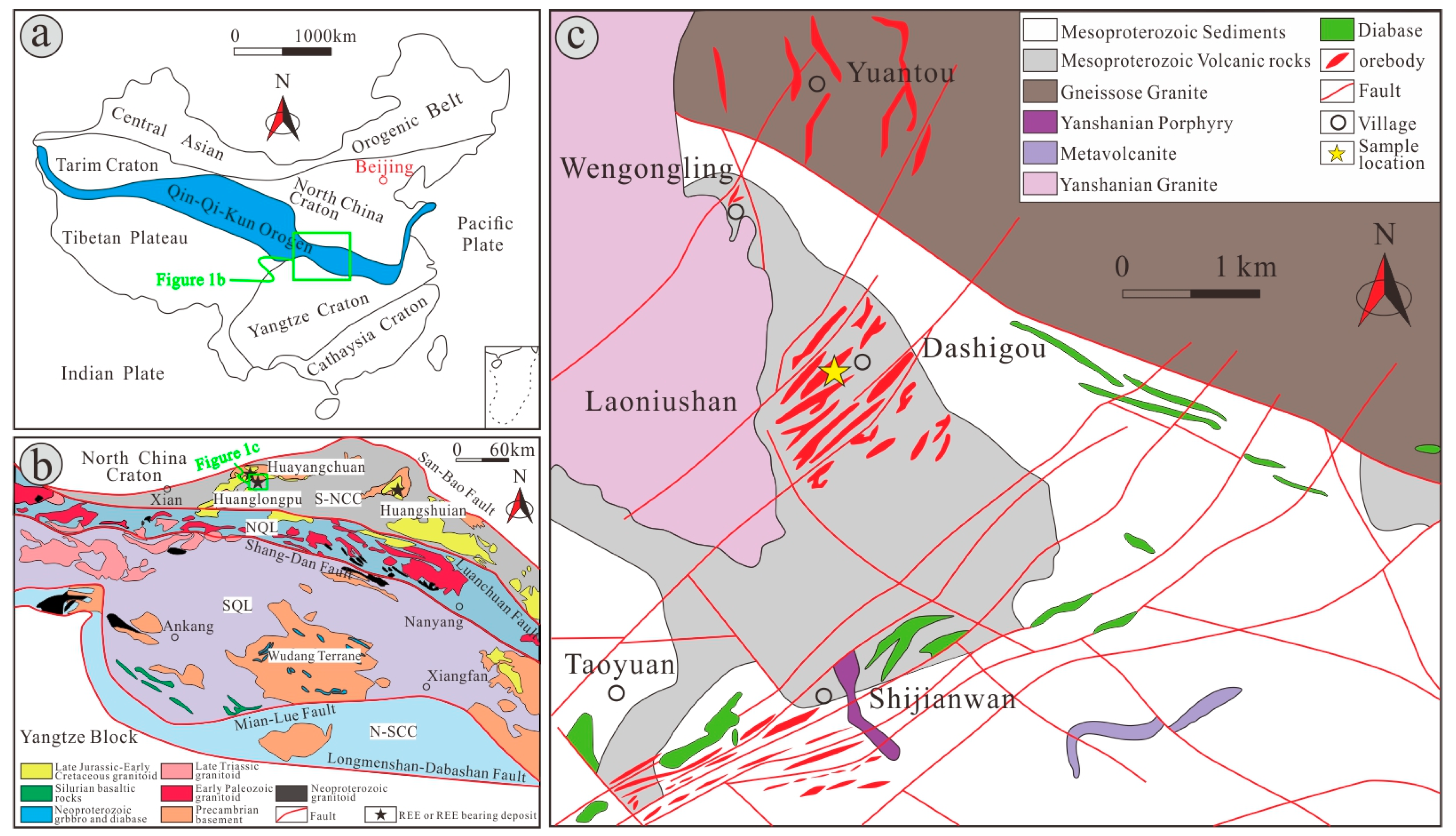
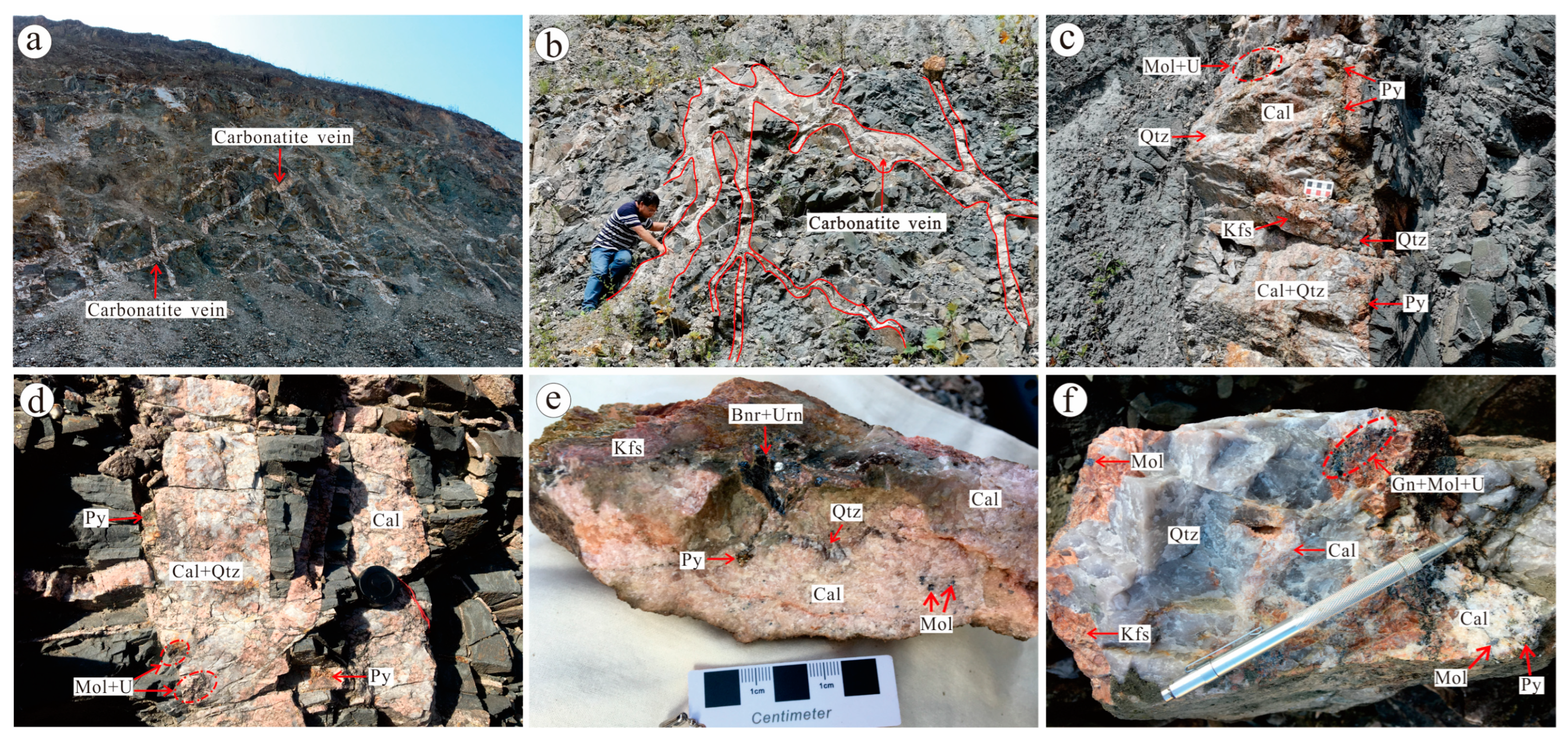
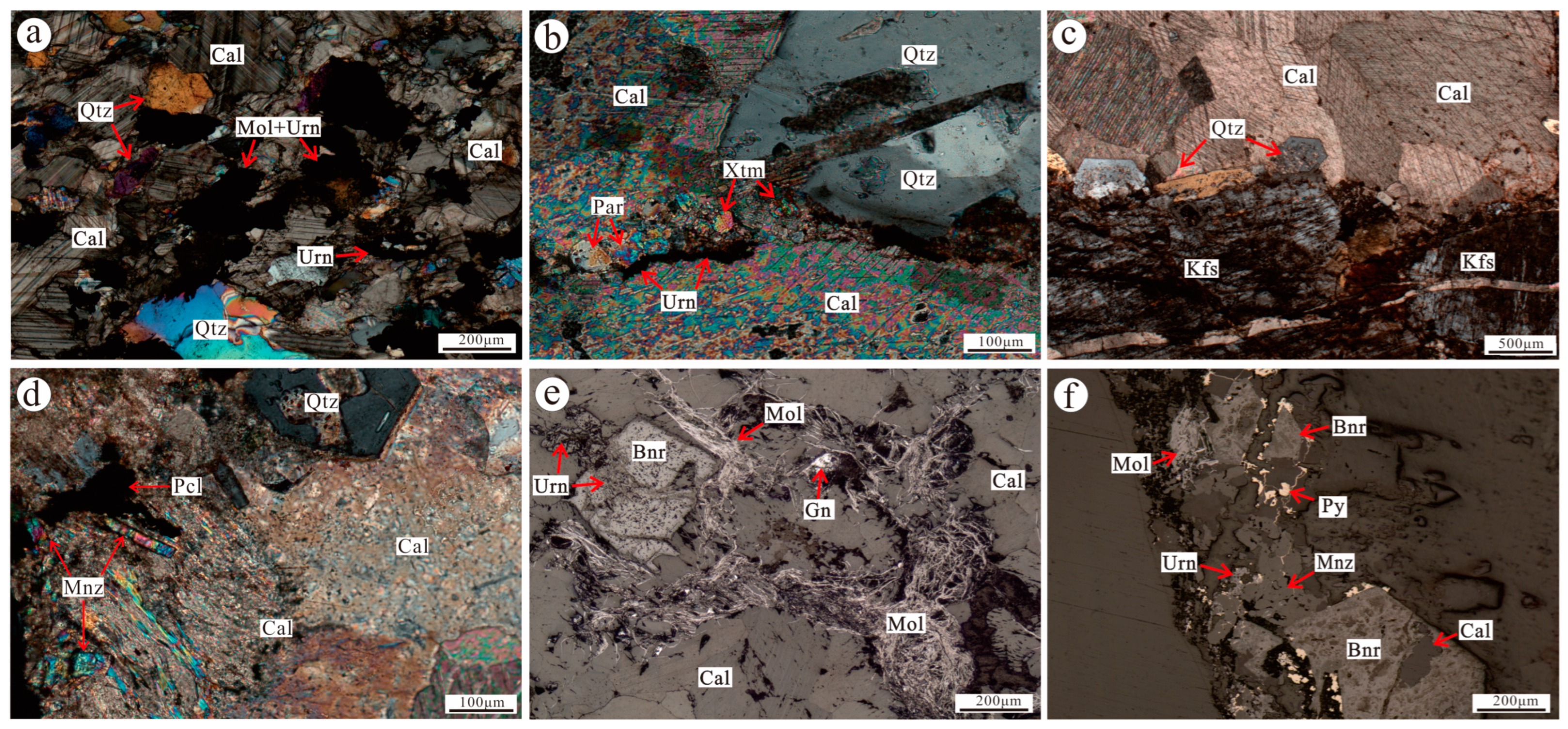
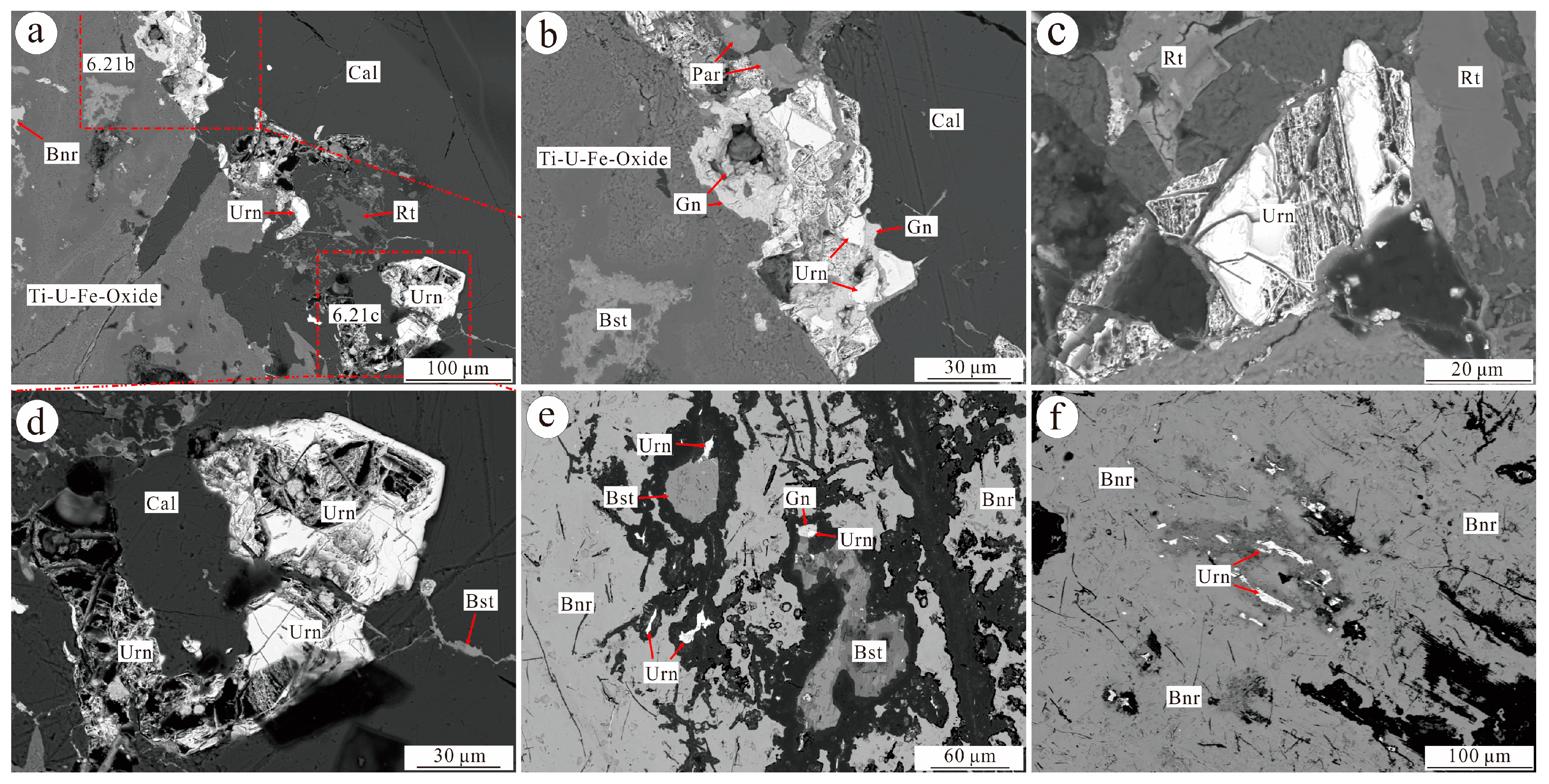
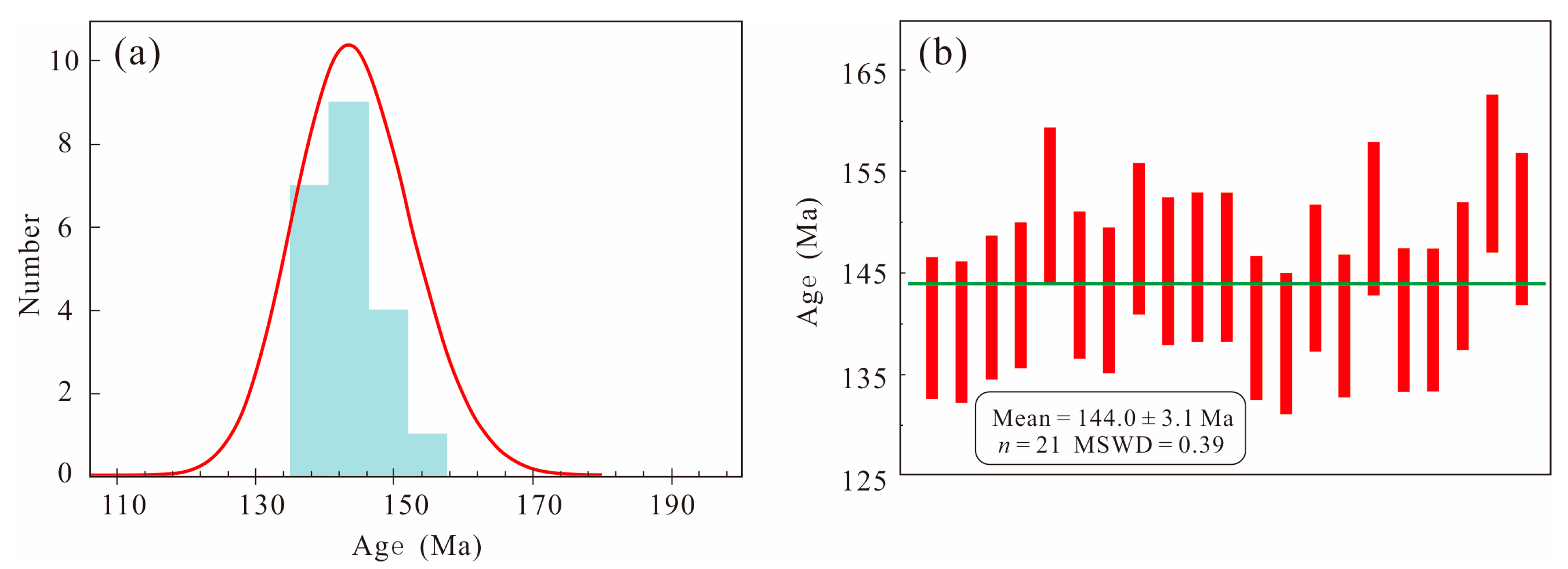
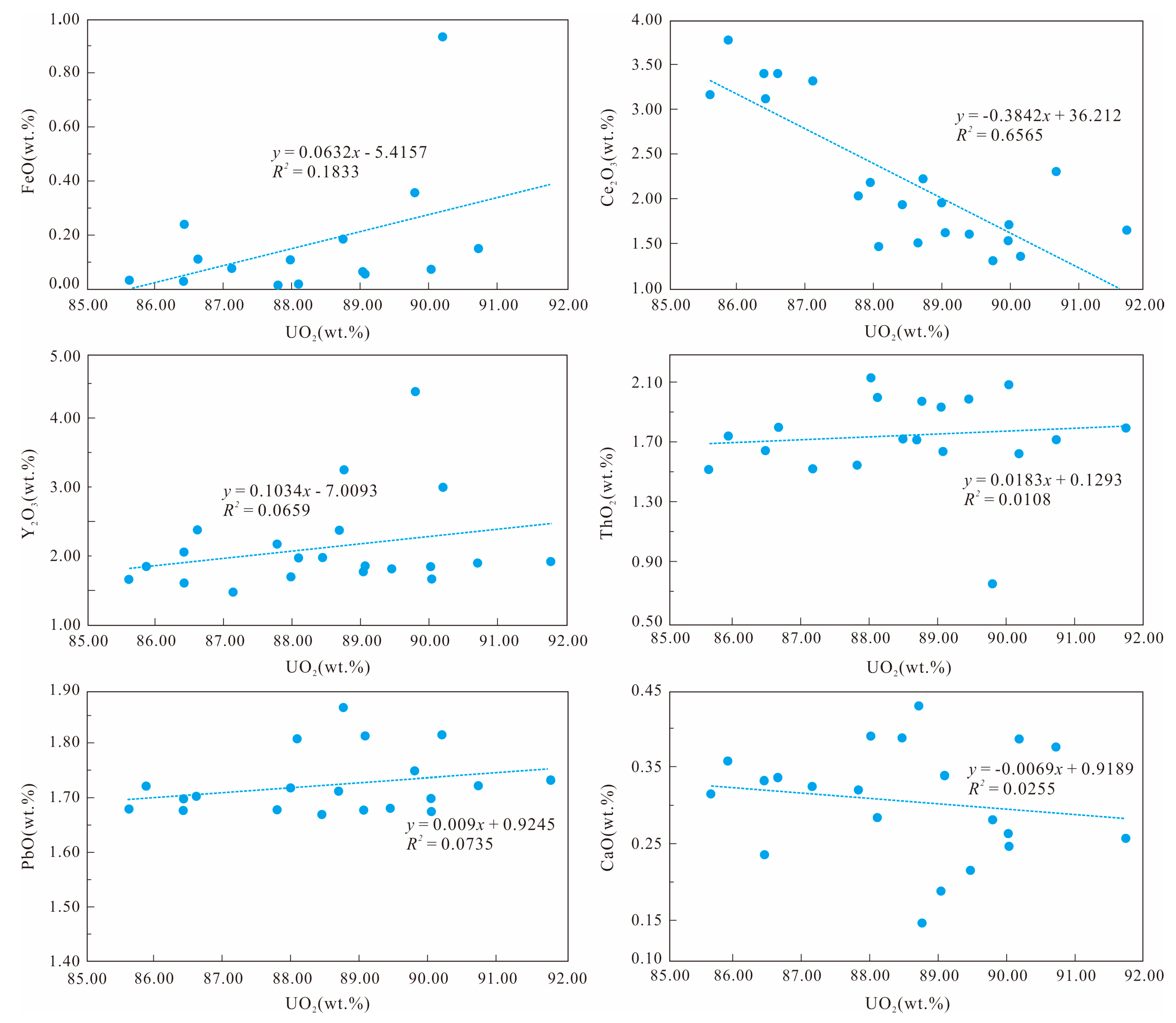

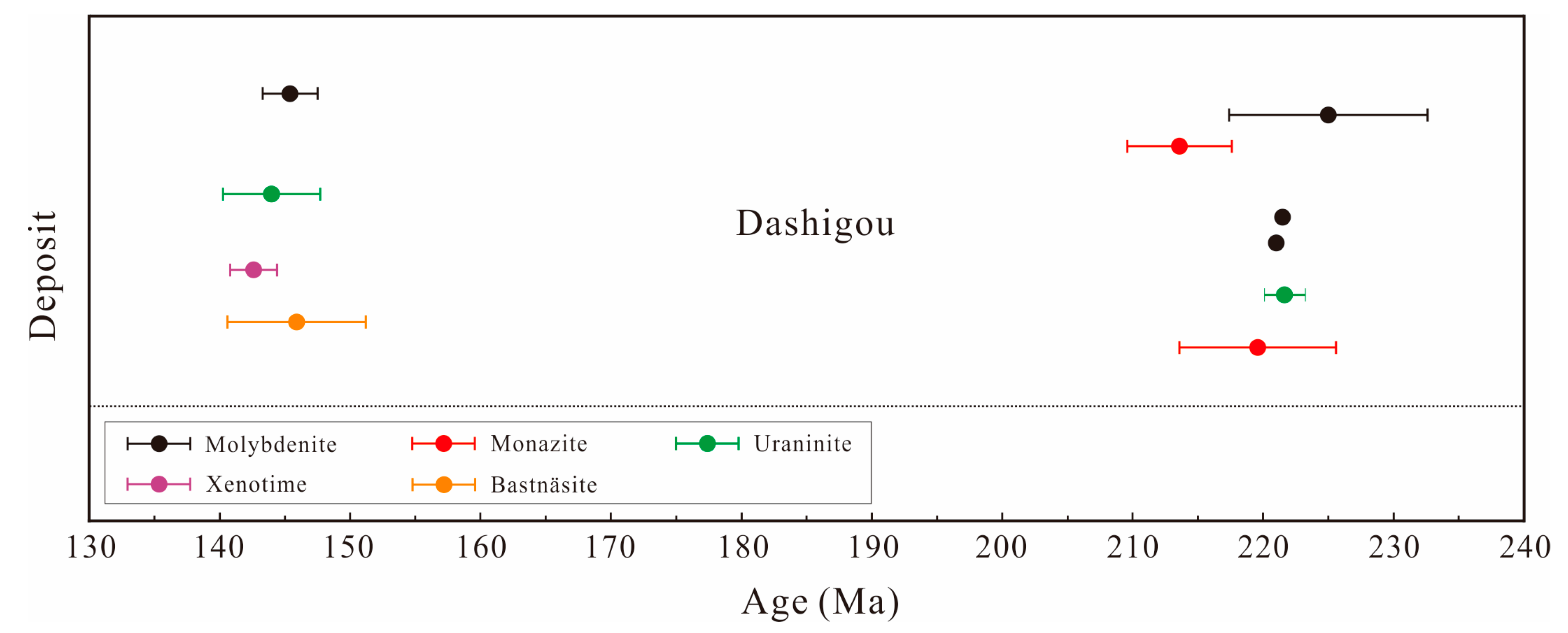
| Test Minerals | Method | Age (Ma) | Reference |
|---|---|---|---|
| Monazite | LA-ICP-MS U–Pb | 219.4 ± 6.0 | [5] |
| Bastnäsite | LA-ICP-MS U–Pb | 145.9 ± 5.3 | |
| Xenotime | LA-ICP-MS U–Pb | 142.6 ± 1.8 | |
| Uraninite | LA-ICP-MS U–Pb | 223 ± 1.0 | [6] |
| Uraninite | EPMA U–Th–Pb | 144 ± 3.1 | This study |
| Molybdenite | Re–Os | 221 | [25] |
| Molybdenite | Re–Os | 221.5 ± 0.3 | [26] |
| Monazite | SIMS Th–Pb | 213.6 ± 4.0 | [22] |
| Molybdenite | ICP-MS Re–Os | 225 ± 7.6 | [46] |
| Molybdenite | ICP-MS Re–Os | 145.4 ± 2.1 | [68] |
Disclaimer/Publisher’s Note: The statements, opinions and data contained in all publications are solely those of the individual author(s) and contributor(s) and not of MDPI and/or the editor(s). MDPI and/or the editor(s) disclaim responsibility for any injury to people or property resulting from any ideas, methods, instructions or products referred to in the content. |
© 2024 by the authors. Licensee MDPI, Basel, Switzerland. This article is an open access article distributed under the terms and conditions of the Creative Commons Attribution (CC BY) license (https://creativecommons.org/licenses/by/4.0/).
Share and Cite
Huang, G.; Wu, D.; Li, F.; Pan, C.; Fan, P.; Min, Z. The Yanshanian Uranium Mineralization Age and Its Geological Significance in the Dashigou Carbonatite-Type Mo-REE-U Deposit, East Qinling Orogen, China. Minerals 2024, 14, 928. https://doi.org/10.3390/min14090928
Huang G, Wu D, Li F, Pan C, Fan P, Min Z. The Yanshanian Uranium Mineralization Age and Its Geological Significance in the Dashigou Carbonatite-Type Mo-REE-U Deposit, East Qinling Orogen, China. Minerals. 2024; 14(9):928. https://doi.org/10.3390/min14090928
Chicago/Turabian StyleHuang, Guangwen, Dehai Wu, Furong Li, Chunrong Pan, Pengfei Fan, and Zhuang Min. 2024. "The Yanshanian Uranium Mineralization Age and Its Geological Significance in the Dashigou Carbonatite-Type Mo-REE-U Deposit, East Qinling Orogen, China" Minerals 14, no. 9: 928. https://doi.org/10.3390/min14090928







